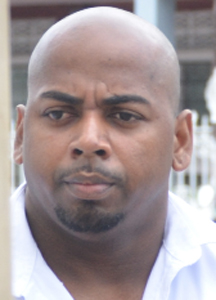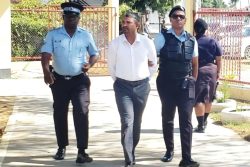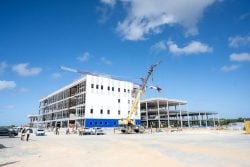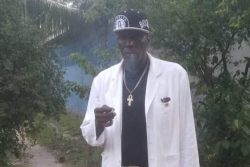DNA testing found a near perfect match in the biological samples which police said they extracted from the body suspected to be that of murdered teen Neesa Gopaul and her mother, Bibi Sharima-Gopaul.
The disclosure was made yesterday by Forensic Analyst Lorrain Alleyne, of the Barbados Forensic Sciences Centre, when she testified via skype from the office of the Guyana Consulate in Barbados at the continuing High Court trial of Sharima-Gopaul, Neesa’s mother, and her co-accused, Jarvis Small.
Responding to questions from State Prosecutor Diana Kaulesar, Alleyne said that the objective of conducting a DNA test of the samples was to determine if the biological tissue of a sample from the lung taken from the body, suspected to be that of Neesa, could have originated from a biological offspring of Sharima-Gopaul. The defence has previously questioned witnesses about the identification of the body, which was missing half of the head.

The court heard from Alleyne that after conducting the test, the DNA bands in the liver tissue sample labelled Neesa Gopaul matched with swabbed mouth samples labelled Sharima-Gopaul.
The analyst explained the comparison of the samples to be a match of 99.98%. This, she said, was indicative of the fact that the sample labelled Neesa Gopaul, originated from the sample labelled Bibi Sharima-Gopaul and not from any other random person.
Alleyne recalled receiving biological samples with labelled markings as having been taken from Sharima-Gopaul, her father Mohamed Kayum, her younger daughter Merriam, as well as from the body suspected to be that of Neesa.

She said that the labelled samples were handed over to her for testing, by Superintendent Stephen Greaves on March 1, 2011. Greaves, who is stationed at the Criminal Investigation Department (CID), Eve Leary and attached to the Police Forensic laboratory, testified on Wednesday that he had travelled to Barbados where he handed over the samples to Alleyne for testing.
‘Scientifically sound’
The DNA certificate on which the findings of the analysis was recorded was tendered and admitted into evidence yesterday.
Asked whether it was possible to have a DNA match of 100%, Alleyne said that a probability of 100% match is not what would usually obtain, while adding that it is not impossible. She explained that to have a reading of 100%, all the DNA in a person’s body will have to be analyzed which could take years.
The analyst was, however, firm in pointing out that if there is no match in the samples, such a finding would be returned with a reading of a 100% no-match; but once there is a match, it is read as 99.98%, “which is considered to be scientifically sound.”
Responding to questions under cross-examination from defence attorney Glenn Hanoman, one of Small’s four lawyers, the witness disagreed with a suggestion from counsel that because she did not include the scientific methodological data of how

findings were arrived at on the DNA certificate, one would be unable to have another analyst look at such data to do a like test. The witness said that all such data is recorded in the case file concerning the subject matter from which the findings were arrived as well as in notes which are taken while the test was being conducted.
Asked whether the lab in Barbados was shut down in 2010 due to the presence of contaminants, the witness said that it was, but emphasised that the closure was due to the presence of mold, “not contaminants.”
Additionally, she explained to Hanoman, when asked, that from her recollection, no reagents were destroyed after the clean-up and sanitisation of the facility.
Explaining that an International Standardisation Organisation (ISO) is an external agency with a mandate for ensuring that work conforms to an established standard, Alleyne admitted that the lab in Barbados was found to be noncompliant with those standards.
Quizzed by counsel, she admitted also that the lab was not ISO complainant when she received the samples in 2011 and that it is still not accredited, though an application was made for such certification even before 2010. The analyst agreed that the system of certification involves the verification of equipment used in the lab also.
Responding to further questions which followed from Hanoman, the witness also agreed that the reliability of her results from testing is dependent on the proper functioning of equipment and that the integrity of the result is paramount in DNA testing.
Alleyne agreed further that a compromised sample can lead to a false result.
Quizzed further by Hanoman, the analyst agreed also that when she testified in the Magistrate’s Court, she said that Greaves did not use the recommended packaging set out in the lab’s manual for the storage of the samples when he took them to the lab in Barbados.
Under cross-examination by George Thomas, Sharima-Gopaul’s attorney, Alleyne answered in the affirmative when asked if it was possible for bacteria to destroy DNA and whether mud and muddy water contains bacteria.
Asked if in such instances the subject matter of the DNA test has to be cleaned, the witness explained that samples are always cleaned.
Under re-examination by state counsel, Alleyne explained to the court that apart from the ISO, there are other internal means by which the accuracy and functionality of equipment and standards are monitored and she cited internal checks as well as positive and negative controls.
Such tests, she said, are conducted before and during the analysis.
Despite occasional interruptions due to technical glitches, Alleyne was able to complete her testimony yesterday.
The defence, which still has to continue it cross-examination of Greaves, will so do when the trial continues on Tuesday at 9am.
Small and Sharima-Gopaul, who are on trial before Justice Navindra Singh and a 12-member jury, are accused of killing the 16-year-old between September 24, 2010, and October 2, 2010, at Madewini, Linden-Soesdyke Highway. The teen’s body had been stuffed into a suitcase, which was anchored in a creek at the Emerald Tower Resort with several dumbbells.





